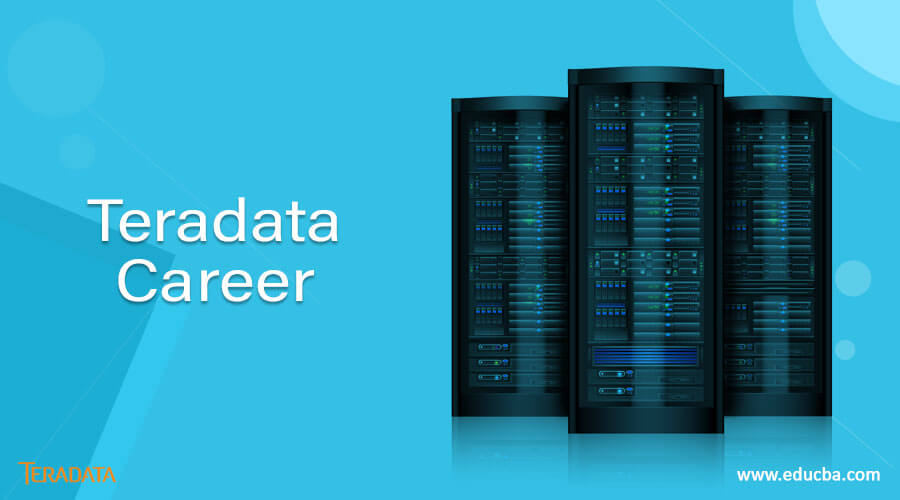
What is Teradata Career?
It is a database that is designed to handle queries. It is a relational database management system for the world’s largest commercial databases. Other RDBMS takes enormous time to process and execute the data. But Teradata RDBMS handles a massive amount of data with ease. Its scalability, parallel processing, and high performance are the main attraction. It generates an optimal plan for the query within a few seconds. Teradata can save up to Teradata bytes in size. The concept of parallelism makes It the industry giant in data warehousing applications. It is based on shared-nothing architecture.
Features of Teradata
The following are some features of Teradata:
1. Faster response
It has the most intelligent optimizer and innovative features to answer any query dynamically.
2. Saves IT effort and time
It is easy to set up and simple to use. It will save a lot of time for your IT department, letting them concentrate on the business’s main goals. Its simple setup, automation processes, and intelligent design are more attractive features of IT people.
3. Analytical Needs
It is ready to solve any query at any time. It deals with complex business trends to customizing web offers. It works with multiple questions simultaneously, making it easy for the user to derive a decision.
4. Manage Data Warehouse at a single click
It contains features that enable faster data warehouse deployment that combines with software controls of memory space, CPU, and security. It has a defined data warehouse that quickly responds to changing business requirements. Teradata’s Defined Warehouse includes three major sections.
- Teradata Workload Management
- Teradata Database Secure Zones
- Teradata Data Lab
5. The Language choice
You can choose your favorite language, which you think will handle the type of questions at its best. You can select Java, Perl, Ruby, Python, R, or any other language script installed in your system to run custom analytics.
6. Structured and Multi Structured Data
It lets you store and analyze structured and multi-structured data in the same database engine. It offers effortless use of all data types within the queries and offers workload management in-database analytics and an easy administration process.
7. Security
The database offers a high level of security that can be customized based on your business’s needs. A few of the security measures are listed below.
- User and system-level password controls
- Wallet for securing credentials
- IP filters
- Row and column-level security
- Full disk encryption
- User authorization and authentication
- Audit logs
8. Row/Column data storage
Teradata Career has an element called Teradata Columnar, which helps integrate column and row-based tables within its Database. It supports advanced workload management, rich SQL, and database analytics.
9. All types of users
It can be used by all users, from businesses to application developers. It is best suited for business users because of its features of leading BI and flexible custom-written business SQL. It is best for application developers because of its language choice and flexible architecture.
10. Bi temporal
You will not need any complex SQL condition clauses. Teradata career makes it more simple for you. It offers full bi-temporal tables and queries.
Benefits of Teradata career
- Automatic data distribution automatically distributes even, uniform, or random data.
- High scalability
- Optimizer – It has a powerful optimizer to perform a lot of operations
- Highly flexible
- Easy to install, use and maintain
- It acts as a single datastore
- Low cost of ownership
- Bulk load facilities
- Full support to GUI
Teradata Career Architecture and Components
The architecture of Teradata RDBMS is designed using shared-nothing architecture.
Teradata Career database systems are of two types:
- SMP (Symmetric Multi-Processing)
- MPP (Massively Parallel Processing)
SMP system is a single NODE system with multiple CPU-sharing memory pools. MPP system has two or more NODES connected by a component called BYNET.
Teradata architecture contains the following components:
1. NODE
This is the collection of hardware and software components and the building block of its database system where the processing occurs. Channel system and network system can be integrated with NODE.
2. PE
Parsing Engine (PE) is a component that interprets SQL requests receives input and transforms the data. The data is transferred through the BYNET to the AMP.
3. PDE
Parallel Database Extension (PDE) runs the operating system on each NODE. It runs Teradata Career Component in parallel.
4. AMP
Access Module Processor (AMP) is a virtual processor designed to manage the database. It sorts, aggregates, and formats data. Each AMP is associated with one virtual disk where there is data stored. It helps to retrieve or update data.
5. System disks
System disks are a part of the NODE that stores data rows. It includes:
- Operating system software
- Teradata software
- Application software
- System dump software
The activities of the database are stored on disk arrays.
6. VPROC (Virtual Processor)
VPROC combines one or more software processes in the OS multi-tasking environment. In Windows OS, VPROC is a single software process. The two types of VPROC are AMP and PE.
7. BYNET (Banyan Network)
BYNET combines hardware and software that provides high-performance networking between the NODES. BYNET is a message-passing layer. It helps the NODES to communicate in a faster way. BYNET hardware and software components handle the communication between the VPROCs. The hardware of BYNET includes boards and cables. The software of BYNET consists of an interface between PDE and BYNET hardware.
The essential features of BYNET include the following:
- Fault Tolerance
- Load Balances
- High Scalability
Teradata Career Data Warehouse System Components
The following are the components:
1. Teradata Database Server
Its Database Server manages a large number of data. It helps in scalability and ensures the integrity of the data.
The database has several modules, which are mentioned below:
- Teradata Database Window – Has control over the operation of the Teradata Career Database
- Teradata Gateway – Controls communications, client messages, and encryption
- Parallel Data Extensions – Enables parallel processing in the Database
- Teradata Database Management Software – This includes Parsing Engine, Access Module Processor, and the File System
2. Teradata Tools and Utilities (TTU)
The important Teradata Career client tools are listed below:
- Teradata SQL Assistant – This is a graphical tool that helps the database development and administration process easy
- Basic Teradata Query (BTEQ) – This is a batch query processing facility
- Loading tools – Helps in loading and unloading applications like TPump, FastExport, Parallel Transporter, and others
- ODBC driver – This is used to accessing the database from other tools and environments.
- OLE DB – This is an interface for manipulating data
- Administrator – This is a database administration interface.
- CLIv2 (Call Level Interface) – This interface between the applications and Teradata Gateway.
- Teradata Manager – This is a set of graphical database management and control tools.
- Performance Monitor – Used for monitoring database sessions, resources usage, and performance statistics
- Visual Explain – Graphical presentation of SQL scripts
- Index Wizard – Increase the index’s performance
- Statistics Wizard – Generates statistics automatically.
- Teradata Archive and Recovery (ARC) – Provides tape archive and recovery process.
- Meta Data Services – Metadata Management System that includes Metadata respiratory, MDS engine, Metamodels, Teradata Metasurf
- Warehouse Builder (WB) – Executes multiple instances of extract, transform, and load processes in the Teradata environment.
3. Teradata Resources
Below listed are a few resources:
- Teradata MultiLoad Guide
- Teradata TPump Tutorial
- Teradata Presentation
- Teradata Express Edition
- Teradata Meta Data Services (MDS)
- Teradata Enterprise Data Warehouse
- Teradata Tutorial
- Teradata String Operations
- Date and Time Manipulation in Teradata
- Select Queries In Teradata SQL
Becoming a Teradata Professional
If you are a Teradata developer or have undergone training in It and looking for a job, this section will help you answer your thoughts and questions about your career. You will know what it means to be a Teradata or Analytics Professional. The first thing you should know is that Data Analytics is a broader term with many names under it. There are a lot of things an analytics professional can do. Several names are given to such professionals as statisticians, Analysts, Data miners, and others. Teradata usually includes exploring data for deeper insight using various sophisticated techniques. Teradata professionals exist under many titles, but all share some core skills and traits. For example, they will be from different educational backgrounds, but still, everyone will know to code in languages like Python, SQL, and others. The difference is that some might know only 2 languages while some might know more than two.
Teradata analysts should have a unique and raw talent profile. They should be dominated by creativity and curiosity. These qualities are prioritized when people are filling up jobs for data analytics. These qualities will help one to understand newer technologies better. As we see, more and more business intelligence solutions are coming up with advanced techniques. So it would help if you were adaptable to this environment to become the right Teradata professional. The distance between the old and new, structured and unstructured data, is now breaking down. You should be creative and more flexible with the developments to make the workflow seamless.
Career Path in Teradata
Is there a career path?
Yes, there is.
Teradata is a company that offers a product with the same name.
It is not a simple database. It is used in many top-rated companies where vast amounts of data need to be stored. World’s most extensive database systems use Teradata.
Only a few top-rated companies use it in India, so the job opportunities are a little fewer. But it is likely to increase in the future. So definitely, Teradata has a better scope.
It is the best choice for your career, mainly if you are into Data Warehousing. Teradata warehousing also lets you work from home.
Whether you are technically fit or not depends on you.
It would help if you had a deeper understanding of the process and systems. Understanding the data more deeply will make you a better developer in the long term. You should also continuously update yourself on recent technologies. There are few certificate courses available in it, and if you learn them, you will have a high demand in the market. Teradata is a rare skill so you can demand a salary from companies.
Teradata Developer
The roles and responsibilities of a Teradata developer are as follows:
- Maintaining all DBA functions
- Performance tuning, which includes collecting statistics and analyzing it
- Create and manage various user accounts
- Move databases between machines
- Upgrade and install patchsets
- Work with data warehousing and data mart
- Create and manage partitions
- Perform database health checks using its Manager
- Provide new and high-quality solutions to clients
- Install its drivers
- Use its Administrator and Manager tools to monitor and control the system.
- Use fast export and fast load utilities to refresh the data
- Load data from various sources and legacy systems into the Teradata production and development warehouse using specific tools
- Analyze and improve query performance using Teradata Explain and Visual Explain
- Create and modify MULTI LOADS for Informatica using UNIX
- Load data into IDW
- Work as an On-site Teradata Lead DBA
- Act as a bridge between the offshore and on-site Teradata teams
Conclusion
Thus it helps many businesses to achieve their objectives with ease. I hope this article has helped you know about your Teradata career.
Recommended Articles
This is a guide to Teradata Career. Here we discussed the basic concept, features, benefits, architecture, and components of Teradata Career. You can also look at the following articles to learn more –

